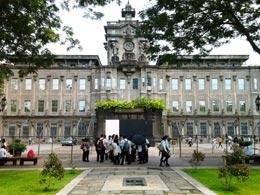Filipino exodus of grads

MARCH is just around the corner. Graduates will be marching to get their diplomas costing an average of half a million pesos.
Most of them will be graduates from six of the most popular college courses: Business Administration and Related; Medical and Allied; Education, Science and Teacher Training; IT-related; Engineering and Technology and Maritime.
Undergraduates will be employed in jobs they are overqualified for. Some will continue with their academic pursuits, Masters or doctorates, medical or otherwise. Healthcare workers – nurses and doctors specifically – are looking at post-graduation unpaid employment or training, if only to get experience reported the Manila Times.
All of these graduates, undergrads and underemployed will be looking for jobs either for the first time or to change careers. A lot of them will be paid entry-level salaries and it will take them at least 5 to 8 years to recoup the tuition fees and related costs of studies that come with a four to five-year degree.
Majority of them do not have connections. Nor do they belong to a political dynasty. And because of that they will seek to be where they can be competitive in a level playing field.
Ten percent of these graduates and undergraduates, even those who are in the early years of their careers will be looking for work abroad. Or better opportunities overseas to join the Overseas Filipinos comprising 10% of the Philippine population
These sectors of the Philippine labor force are in the 25 to 39 age bracket, a desirable population demographic especially to countries with aging and retiree or retiring population usually found in the five countries with permanent migration programs (FCWPMP): Australia, Canada, New Zealand, the United Kingdom and the United States.
Unless the younger workforce in these countries increase, their retirees and elderly are not likely to get their pension, retirement and other benefits.
While the FCWPMP welcome young foreign graduates, workers and immigrants, they have fine-tuned their programs to give first crack to the 25 to 39 age bracket because they want workers who will not only be able to contribute to the social security system but also would productive and contributive before they themselves join the ranks of the retired and elderly.
And not just any 25 to 39 year old graduate, undergraduate or early entrants to the job market.
Not only do the FCWPMP prefer the young workers and immigrants but they also give preference to those in certain occupations that will help or keep a member of the FCWPMP competitive in the global marketplace.
Looking back at the number of graduates from the five of the most popular degree programs in the Philippines, the Medical and Allied Discipline have the most number of graduates for the academic year 2014-2015 pegged at 171,149 by the Commission on Higher Education. Closely following are graduates of Busines Administration and Related courses (125,954); IT-related (60,517); Engineering and Technology (59,108) and graduates of Education, Science Teacher Training courses at 54,727.
For these young graduates, early labor entrants and even undergraduates, Australia assigns the highest number of points based on age. A skilled worker intending to apply for permanent residency in Australia in the 25 to 32 age range gets 30 points, half of the total points needed to qualify for permanent migration. The 33 to 39 year old skilled worker applicants get 25 points.
New Zealand also gives the same number of points to the similar age brackets. While the minimum points needed to qualify for permanent residency in Australia is 60; a Skilled Migrant applicant for new Zealand requires 140 points to be invited to apply for permanent residency.
Canada on the other hand gives 110 points to a permanent resident applicant in the 20 to 29 age bracket with decreasing points assignment for every year an applicant gets older, leaving only 55 points for the 39-year olds.
Australia and New Zealand have lists of occupations in demand. Canada does not. However, under the new selection process called Express Entry, applicants for permanent residency in Canada must have either a job offer from a qualified Canadian employer or be nominated by a State or Territory. Each of these two factors will give the skilled migrant applicant 600 points. An Express Entry applicant or candidate can get a maximum of 1,200 points.
Invitations to apply for permanent residency are issued based on a candidate or applicants ranking in the pool of qualified candidates. In the last round of invitations, the lowest score of those invited was more than 700 points.
The average applicant from the Philippines who is in the age bracket of 22 to 32, single, has no children, has a 4-year diploma, an intermediate level in English proficiency and two years experience will get anywhere from 280 to 312 points. Too low to be invited to apply unless he or she gets either an arranged offer of employment from a Canadian employer or a nomination from any of the Canadian provinces or territories.
Getting a job offer from an employer in Australia, Canada or New Zealand while in the Philippines is extremely difficult because employers in those countries prefer posting their vacancies at the jobs boards of colleges and universities where foreign or international students are allowed to work while studying.
In addition, these foreign or international students after completing at least a one-year post-secondary diploma and get the first crack for sponsorship and permanent employment as a result of having completed the diploma course and having direct access to employers.
In fact, new graduates who opt to continue further studies abroad earn about five times more than a new graduate lucky enough to find a full-time entry-level job, overqualified and underemployed but a job nevertheless.
– Manila Times






